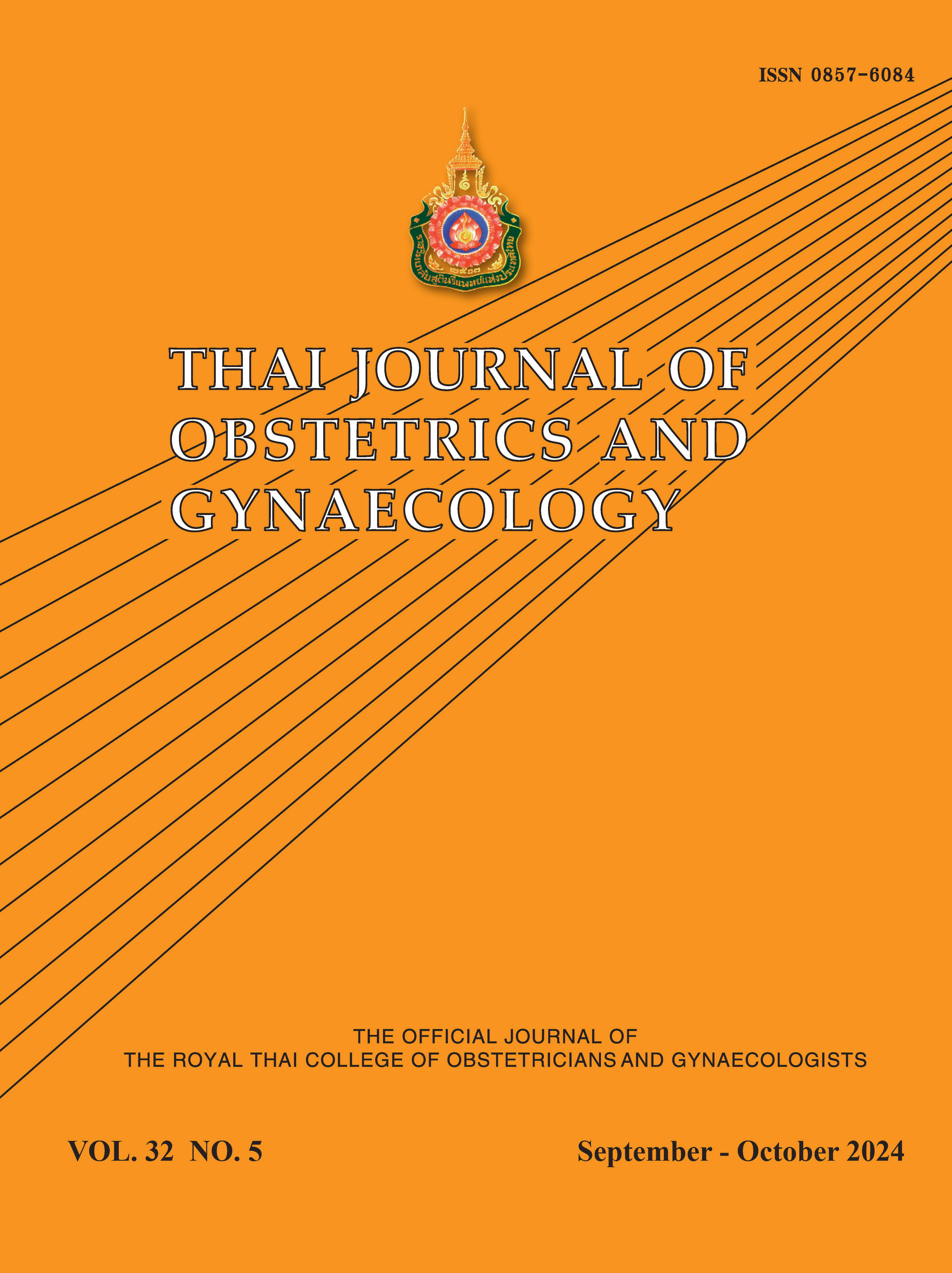Prevalence and Associated Factors of Iron- Deficient Erythropoiesis in Thai Pregnant Women
Main Article Content
Abstract
Objectives: The primary objective was the prevalence of iron-deficient erythropoiesis (IDE) in Thai pregnant women during early pregnancy, with the identification of associated factors as the secondary goal.
Materials and Methods: A cross-sectional survey was conducted on pregnant women aged ≥ 20 years, who visited the antenatal clinic during the first 14 weeks of gestation without anemia. IDE was defined as hemoglobin level ≥ 11 g/dL and serum ferritin < 30 ng/mL.
Results: A total of 130 pregnant women were enrolled. IDE was detected in 10.77% (95% confidence interval 6.26 - 16.83). In univariate analysis, various factors with p value of ≤ 0.2 were identified. From multivariate analysis of these factors, the number of pregnancies (parity ≥ 2) was significantly associated with IDE (adjusted odds ratio 5.728, 95% confidence interval 1.019 - 32.210, p = 0.048).
Conclusion: Out of every 100 pregnant women without anemia, 10 had IDE in early pregnancy. Multiparity emerged as the most significant factor for IDE.
Article Details

This work is licensed under a Creative Commons Attribution-NonCommercial-NoDerivatives 4.0 International License.
References
Friedrisch JR, Friedrisch BK. Prophylactic iron supplementation in pregnancy: A controversial issue. Biochem Insights 2017;10:1178626417737738.
Kassebaum NJ, Jasrasaria R, Naghavi M, Wulf SK, Johns N, Loano R, et al. A systematic analysis of global anemia burden from 1990 to 2010. Blood 2014;123: 615-24.
Sukrat B, Sirichotiyakul S. The prevalence and causes of anemia during pregnancy in Maharaj Nakorn Chiang Mai Hospital. J Med Assoc Thai 2006;89 Suppl 4: S142-6.
Milman N. Prepartum anaemia: prevention and treatment. Ann Hematol 2008 ;87:949-59.
Teichman J, Nisenbaum R, Lausman A, Sholzberg M. Suboptimal iron deficiency screening in pregnancy and the impact of socioeconomic status in a high-resource setting. Blood Adv 2021;5:4666–73.
Al-Naseem A, Sallam A, Choudhury S, Thachil J. Iron deficiency without anaemia: a diagnosis that matters. Clin Med (Lond) 2021;21:107-13.
Sritippayawong S, Wong P, Chattrapiban T. Iron deficiency anemia during pregnancy in the lower north of Thailand-prevalence and associated factors. MJPHM 2012;12:1-5.
Liao QK; Chinese Children, Pregnant Women & Premenopausal Women Iron Deficiency Epidemiological Survey Group. Prevalence of iron deficiency in pregnant and premenopausal women in China: a nationwide epidemiological survey. Zhonghua Xue Ye Xue Za Zhi 2004;25:653-7.
Iglesias-Vázquez L, Gimeno M, Coronel P, Caspersen IH, Basora J, Arija V. Maternal factors associated with iron deficiency without anaemia in early pregnancy: ECLIPSES study. Ann Hematol 2023;102:741-8.
Siu AL; U.S. Preventive Services Task Force. Screening for iron deficiency anemia and iron supplementation in pregnant women to improve maternal health and birth outcomes: U.S. Preventive Services Task Force Recommendation Statement. Ann Intern Med 2015;163:529-36.
Loy SL, Lim LM, Chan SY, Tan PT, Chee YL, Quah PL, et al. Iron status and risk factors of iron deficiency among pregnant women in Singapore: a cross-sectional study. BMC Public Health 2019;19:397.
Miller EM. Iron status and reproduction in US women: National Health and Nutrition Examination Survey, 1999-2006. PLoS One 2014;9:e112216.
Nutritional anaemias. Report of a WHO scientific group. World Health Organ Tech Rep Ser 1968;405:5-37.
Bothwell TH. Iron requirements in pregnancy and strategies to meet them. Am J Clin Nutr 2000;72(1 Suppl):257S-264S.
Caspersen IH, Iglesias-Vázquez L, Abel MH, Brantsæter AL, Arija V, Erlund I, et al. Iron status in mid-pregnancy and associations with interpregnancy interval, hormonal contraceptives, dietary factors and supplement use. Br J Nutr 2021;126:1270-80.
Zimmermann MB, Hurrell RF. Nutritional iron deficiency. Lancet 2007;370:511-20.


